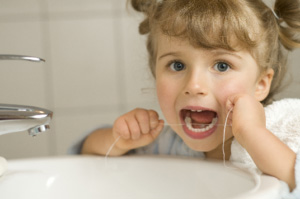
As a parent, there is nothing more beautiful than your child’s smile. To foster the health and beauty of it, you work hard to promote proper oral hygiene habits. From a young age, you have introduced brushing twice a day and take them to their dentist regularly to nurture their oral health, but what about flossing? Just as with adults, flossing is vital to protecting your child’s teeth from damage, like tooth decay. It is recommended that they start to have their teeth flossed around the age of two.
Does My Child Need to Floss?
As an adult, you know that flossing is vital to preventing gum disease; however, for children, it is important for reducing cavities, like those that can develop in between the teeth. With tooth decay the leading chronic illness treated in children, flossing provides a proactive means to reduce their risk for a preventable cavity.
When Should My Child Start Flossing?
It is recommended that children begin to have their teeth flossed around the age of two because they become closer together. However, they will not be ready to floss on their own at this point. It is not until around the age of 10 that they can begin to perform the task on their own with supervision. When they are ready, young children find it easier to use a dental flosser instead of traditional floss.
Not only will flossing help to keep their smile healthy, but offer the perfect foundation for the importance of oral hygiene once their permanent teeth start to come in.
How Do I Start Flossing My Child’s Teeth?
When introducing flossing, it all starts with a good dental floss. When picking one, look for those that are supported by the American Dental Association with their Seal of Acceptance. This means that is has been tested for safety and effectiveness. In addition, choose one that is soft and flexible to prevent any irritation to their gums.
Use about 18 inches of floss that is wrapped loosely around your middle fingers. Gently slide it between two of their teeth, keeping it taut. Be careful when doing this so you do not snap it on their gums. Then, form a “C” shape around a tooth and gently move it up and down from the crown to the gum line. Repeat this process for each tooth.
As your child becomes older, you can begin to allow them to floss their own teeth; however, be sure to supervise them carefully.
Promote a Heathy Smile
Your child’s oral hygiene habits are their first line of defense against dental issues. In addition to home care, do not forget to schedule a cleaning and checkup with a kid’s dentist twice a year.
About Northampton Pediatric Dentistry PC
Northampton Pediatric Dentistry PC caters to the smiles of children. As a dentist in Northampton that specializes in pediatric dentistry, we help to foster the health and development of their teeth. If you have any questions about your child’s home oral hygiene habits, please contact our office.
